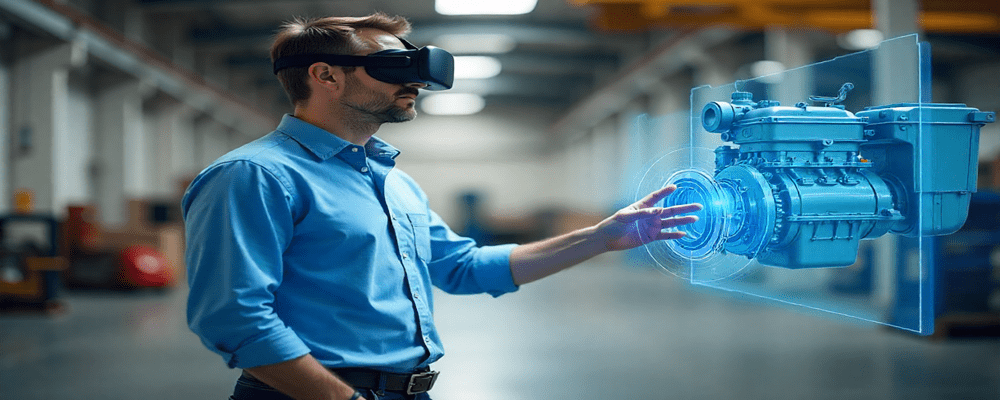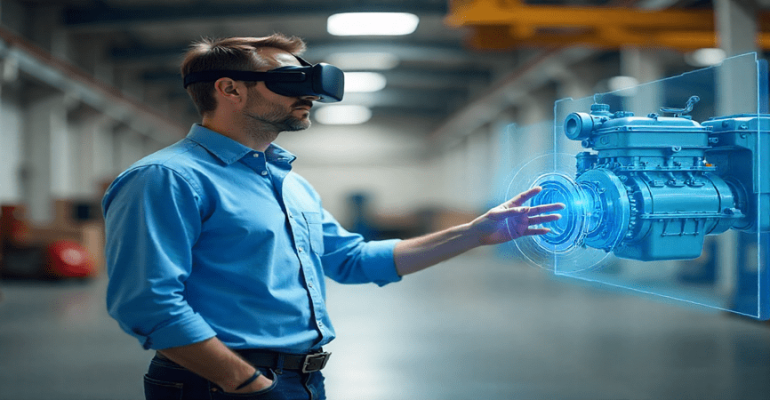
Rebuilding Assembly Lines Virtually: An XR Use Case

Rebuilding Assembly Lines Virtually: An XR Use Case
The manufacturing of machinery is changing more quickly than it has in the past. Businesses are under tremendous pressure to optimize assembly lines, decrease downtime, increase efficiency, and scale production without incurring significant overhead costs as Industry 4.0 transforms global production. However, optimizing an assembly line using traditional approaches is frequently expensive, time-consuming, and disruptive.
Imagine being able to digitally restructure your assembly line, test various layouts, streamline processes, and even train your employees prior to implementation, all without having to move a single machine from the factory floor. That is Extended Reality’s (XR) power.
The Challenge of Traditional Assembly Line Optimization
CAD designs, floor planning, physical trial-and-error, and real-world testing have been the mainstays of assembly line optimization for decades. Despite being the norm, this has drawbacks that have an immediate effect on expenses and productivity:
- High setup costs: Rearranging machines and workstations in real life needs personnel, time, and substantial expenses.
- Downtime: Production stops whenever a layout is tested or changed, which results in lost revenue.
- Safety risks: Operators confront potential hazards when adjusting to new layouts.
- Limited testing opportunities: It can be challenging to test several “what-if” scenarios because simulations are frequently constrained.
These difficulties might result in postponed production schedules, higher operating expenses, and decreased productivity in the cutthroat manufacturing market of today.
Here, XR-driven virtual optimization fills the gap between implementation and planning.
How XR is Transforming Assembly Line Optimization
Modeling Line Layouts Prior to Execution:
Manufacturers can use XR to build a virtual assembly line that is identical to their actual manufacturing floor.
This enables those who make decisions to:
- Imagine various workstation configurations and machine locations.
- Measure cycle times and model the production flow.
- Prior to implementing physical modifications, identify hazards, bottlenecks, and inefficiencies.
Managers can save time and prevent expensive trial-and-error by electronically dragging, dropping, and rearranging machines rather than physically moving them.
Examining Interaction Between Humans and Machines:
Operator ergonomics is one of the most neglected elements in assembly line design. Reduced throughput, worker weariness, and safety concerns might result from ineffective arrangements.
Managers can test human-machine and workflow interactions in a simulated environment with XR. For instance:
- Are parts and tools easily accessible?
- Does the operator need to move in needless ways?
- Is there enough room for machines to interact safely?
Businesses can increase overall productivity and operator safety by virtually enhancing ergonomics.
Online Instruction Without Production Stoppage:
Safety precautions and production interruptions are frequently necessary when training operators on a redesigned manufacturing line. XR allows for the virtual training of new operators:
- Practical experience with machinery without running the danger of mishaps.
- Learning Standard Operating Procedures (SOPs) in a methodical manner.
- Interactive, gamified training that increases retention.
This lowers mistakes and boosts productivity right away by giving workers the confidence and abilities they need before they ever set foot on the actual production floor.
Improving Logistics and Material Flow:
In assembly lines, inefficient material handling is one of the hidden expenses. Inadequately designed layouts result in waste, delays, and needless movement.
Using simulations driven by XR, managers can:
- Examine various material flow paths.
- Imagine the flow of finished goods and raw materials across the floor.
- Reduce traffic and guarantee seamless supply chain integration.
Faster turnaround times, less waste, and leaner operations are the results of this.
Constant Improvement and Predictive Maintenance:
XR can support continuous optimization and predictive maintenance when combined with IoT and AI. For example:
- Create scenarios of machine failure.
- Determine the process’s weak points.
- Before implementing changes in real life, test them electronically.
This ensures minimal downtime and continuous production by assisting plant managers in transitioning from reactive maintenance to proactive decision-making.
XR’s advantages for plant managers, COOs, and CEOs
For decision-makers, XR is about ROI and economic value, not just technology. The following are the main advantages:
- Lower Costs: Gets rid of costly trial-and-error when it comes to physical line reconfiguration.
- Faster Decision-Making: Leaders can complete layouts more rapidly with the use of data-driven simulations.
- Increased Safety: Recognizes risks and offers instruction for safe operation.
- Increased Productivity: Streamlined processes boost output without requiring additional resources.
- Scalability: Fits well with manufacturing processes at all scales.
Example of a Real-World Case
A multinational automaker essentially redesigned its engine production line using XR. Using a digital twin to test several layouts, the business:
- 30% decrease in rework expenses.
- reduced reconfiguration downtime by 25%.
- 40% increase in operator efficiency.
The finest aspect? Before even setting foot on the real manufacturing floor, all of this was accomplished.
Imagine what XR may do for machinery makers across industries if a major in the automotive industry can make such gains.
Advantage in Industry 4.0
Manufacturers who only use conventional optimization techniques run the danger of falling behind as global competition heats up. Digital twins, XR-based processes, and smart manufacturing solutions are already giving rivals a competitive edge through quicker innovation, cheaper expenses, and safer operations.
Adoption of XR by CXOs is about future-proofing the company, not only about enhancing assembly lines. It means fewer interruptions and more efficient operations for plant managers. It gives trainers safer, quicker, and more interesting options to upskill employees.
Is XR the Assembly Line Optimization of the Future?
The answer is definitely yes. XR is now a necessary tool for producers who wish to stay competitive in the digital age, not just a futuristic idea.
Prior to implementation, XR makes sure that assembly lines are optimized for optimal productivity by integrating digital twins, real-time simulations, and immersive training.
Early adopters will benefit from lower expenses, increased productivity, and long-term growth, while late adopters run the risk of inefficiency and missed opportunities.
Why Sapizon?
Despite the obvious advantages of XR, its successful deployment necessitates the right technology partner, one who is knowledgeable about both the technology and the difficulties faced by the manufacturing sector.
Sapizon Technologies can help with that.
Our specialty at Sapizon is XR solutions designed for the machinery manufacturing sector. Our specialty is creating VR-based training materials, AR-powered process optimization tools, and immersive digital twins that are intended to produce quantifiable business outcomes.
- Industry Experience: Using XR, we have streamlined operations for several manufacturing companies.
- Tailored Solutions: We provide solutions that are specific to your factory’s requirements because every assembly line is different.
- End-to-End Support: We collaborate with your teams to guarantee seamless adoption from consultation to deployment.
- ROI-Driven Approach: We’re not just focused on putting XR into practice; we’re also working to assist you get a quicker return on investment through cost reductions, increased output, and safer operations.
If you work as a trainer, plant or decision maker in the machinery manufacturing industry, join hands with Sapizon Technologies now, and together, we can virtually redesign your assembly line before it is put into use to make it a safer, smarter, and more efficient system.